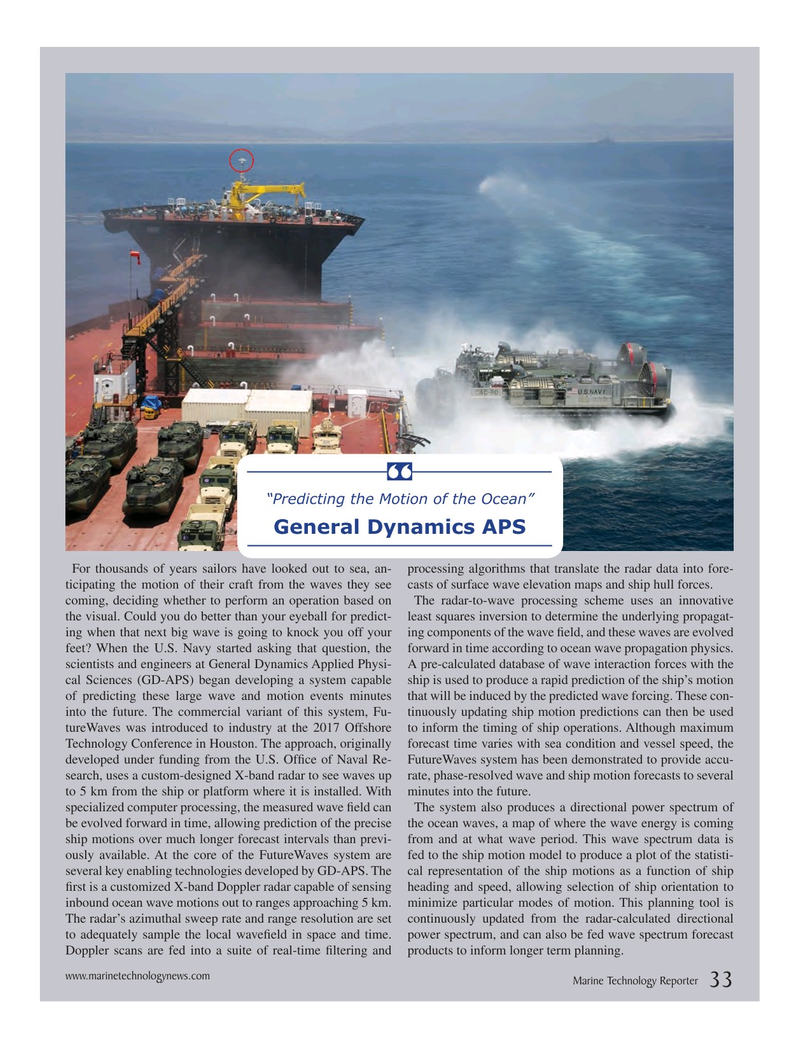
Page 33: of Marine Technology Magazine (July 2017)
THE MTR 100 - 12th Annual Listing of 100 Leading Subsea Companies
Read this page in Pdf, Flash or Html5 edition of July 2017 Marine Technology Magazine
“ “Predicting the Motion of the Ocean”
General Dynamics APS
For thousands of years sailors have looked out to sea, an- processing algorithms that translate the radar data into fore- ticipating the motion of their craft from the waves they see casts of surface wave elevation maps and ship hull forces.
coming, deciding whether to perform an operation based on The radar-to-wave processing scheme uses an innovative the visual. Could you do better than your eyeball for predict- least squares inversion to determine the underlying propagat- ing when that next big wave is going to knock you off your ing components of the wave ? eld, and these waves are evolved feet? When the U.S. Navy started asking that question, the forward in time according to ocean wave propagation physics. scientists and engineers at General Dynamics Applied Physi- A pre-calculated database of wave interaction forces with the cal Sciences (GD-APS) began developing a system capable ship is used to produce a rapid prediction of the ship’s motion of predicting these large wave and motion events minutes that will be induced by the predicted wave forcing. These con- into the future. The commercial variant of this system, Fu- tinuously updating ship motion predictions can then be used tureWaves was introduced to industry at the 2017 Offshore to inform the timing of ship operations. Although maximum
Technology Conference in Houston. The approach, originally forecast time varies with sea condition and vessel speed, the developed under funding from the U.S. Of? ce of Naval Re- FutureWaves system has been demonstrated to provide accu- search, uses a custom-designed X-band radar to see waves up rate, phase-resolved wave and ship motion forecasts to several to 5 km from the ship or platform where it is installed. With minutes into the future.
specialized computer processing, the measured wave ? eld can The system also produces a directional power spectrum of be evolved forward in time, allowing prediction of the precise the ocean waves, a map of where the wave energy is coming ship motions over much longer forecast intervals than previ- from and at what wave period. This wave spectrum data is ously available. At the core of the FutureWaves system are fed to the ship motion model to produce a plot of the statisti- several key enabling technologies developed by GD-APS. The cal representation of the ship motions as a function of ship ? rst is a customized X-band Doppler radar capable of sensing heading and speed, allowing selection of ship orientation to inbound ocean wave motions out to ranges approaching 5 km. minimize particular modes of motion. This planning tool is
The radar’s azimuthal sweep rate and range resolution are set continuously updated from the radar-calculated directional to adequately sample the local wave? eld in space and time. power spectrum, and can also be fed wave spectrum forecast
Doppler scans are fed into a suite of real-time ? ltering and products to inform longer term planning.
www.marinetechnologynews.com
Marine Technology Reporter 33
MTR #6 (18-33).indd 33 MTR #6 (18-33).indd 33 8/1/2017 9:41:54 AM8/1/2017 9:41:54 AM

 32
32

 34
34
